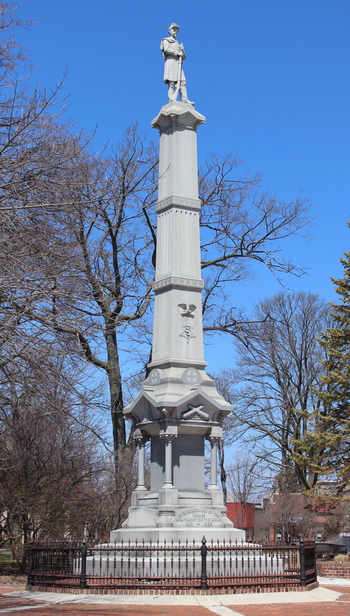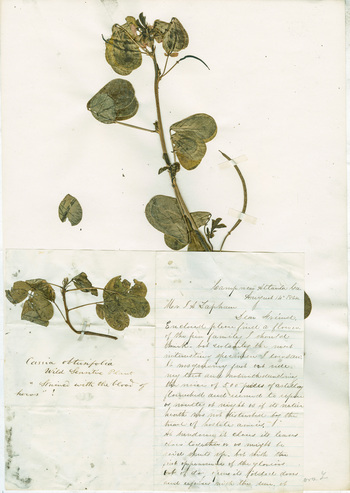Flower links Civil War, natural history and ‘the blood of heroes’
A plant specimen collected by a captain in the 1st Wisconsin Regiment, John Cornelius McMullen, during a Civil War battle near Atlanta, Georgia on Aug. 14, 1864. The notation reads “Stained with the blood of heros”!
On August 14, 1864, in a Union Army camp in Georgia, a captain from Wisconsin plucked a plant, pressed it onto a sheet of paper, wrote a letter describing the plant as “certainly the most interesting specimen I ever saw,” and sent it with the plant to a scientist he called “Friend” in Wisconsin.
“It was growing outside my tent and notwithstanding the noise of 500 pieces of artillery flourished,” wrote John Cornelius McMullen, “and seemed to repose as sweetly at night as if its native heath was not disturbed by the tread of hostile armies.”
The captain-collector was clearly literate, even poetic.
Ken Cameron, director of the Wisconsin State Herbarium and professor of botany, inspects the historic specimen.
The scientist, Increase Lapham (1811-1875), is today considered the founder of natural history in Wisconsin. A geologist, botanist and historian, he is the subject of a new biography, “Studying Wisconsin: The Life of Increase Lapham,” published by the Wisconsin Historical Society Press.
And but for that book, a plant specimen that Wisconsin State Herbarium director Ken Cameron calls “perhaps our most astonishing of all” might never have surfaced from the 1.2 million dried plants in the collection on the University of Wisconsin–Madison campus.
Because Lapham’s personal plant collection actually founded the herbarium more than 160 years ago, authors Paul G. Hayes and Martha Bergland held a reading of the biography at the herbarium, located in the Department of Botany, in October. In preparation, the herbarium put on display some of Lapham’s original specimens, including the 150-year-old sheet holding Cassia obtusifolia (“Wild Sensitive Plant”). “We started to read the letter attached to it,” says Cameron. “The sender described the flower as ‘stained with the blood of heroes,’ and that really caught our eyes!”
Capt. McMullen sent the plant specimen to scientist Increase A. Lapham, considered the founder of natural history in Wisconsin.
Who was this lyrical captain? John Cornelius McMullen was apparently born in Delaware or New Jersey and graduated from Lawrence University in Appleton, Wisconsin. He entered the First Wisconsin Regiment on Sept. 16, 1861 from Sheboygan Falls, fought with them and was wounded, through Kentucky, Tennessee and northern Georgia under General Sherman.
The plant and the letter were both a surprise, says co-author Bergland, a retired English teacher from Glendale, Wisconsin. “I did not know about it until we showed up to do the reading. It’s wonderful that it was discovered, but I think Lapham would have had a very ambivalent response to such a letter. He was a Quaker, a pacifist — did not want anything to do with war. But he was very supportive … of veterans, especially wounded veterans.”
In his letter, McMullen laid out the circumstances of the First Wisconsin Regiment. “We are now in plain view of the great commercial city of Georgia. My company are in the front line of works only a half mile from town and while I write shot and shells are constantly passing over us. It may be some days before Atlanta falls but in the end it must yield for the best army in the world are thundering at its gate.”

Sheboygan County (Wisconsin) Civil War Memorial. McMullen entered the 1st Wisconsin Regiment from Sheboygan Falls.
Despite his surroundings — or perhaps because of them — McMullen concluded on a sentimental note: “This flower was moistened by the blood of heroes, for Wisconsin men have died where it was plucked.”
McMullen worked for the federal government in Tennessee after the war, and may have moved to Oakland, California, where a man of the same name and general age was described as running a bank.
An herbarium is a venerable repository of pressed and dried plant specimens that serves as a reference library for plants. Although they are now being used scientifically in ways they never imagined a century ago, Cameron, also a professor of botany at UW–Madison, says this mystery, worthy of Antiques Roadshow, demonstrates another side of these collections.
“This specimen shows that our collection also has value for understanding history and bridging the sciences with the humanities. This comes down from a time when all well-educated people had a different view of nature and collecting plants was a common activity. There are treasures in the collection that we don’t know we are sitting on.”




